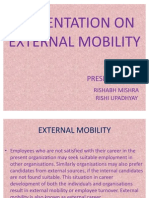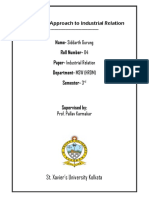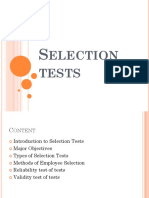Selection, Orientation & Placement
Selection, Orientation & Placement
Uploaded by
Pankaj2cCopyright:
Available Formats
Selection, Orientation & Placement
Selection, Orientation & Placement
Uploaded by
Pankaj2cOriginal Description:
Original Title
Copyright
Available Formats
Share this document
Did you find this document useful?
Is this content inappropriate?
Copyright:
Available Formats
Selection, Orientation & Placement
Selection, Orientation & Placement
Uploaded by
Pankaj2cCopyright:
Available Formats
EMPLOYEE SELECTION PROCESS Employee Selection is the process of putting right men on right job.
It is a procedure of matching organizational requirements with the skills and qualifications of people. Effective selection can be done only when there is effective matching. By selecting best candidate for the required job, the organization will get quality performance of employees. Moreover, organization will face less of absenteeism and employee turnover problems. By selecting right candidate for the required job, organization will also save time and money. Proper screening of candidates takes place during selection procedure. All the potential candidates who apply for the given job are tested. But selection must be differentiated from recruitment, though these are two phases of employment process. Recruitment is considered to be a positive process as it motivates more of candidates to apply for the job. It creates a pool of applicants. It is just sourcing of data. While selection is a negative process as the inappropriate candidates are rejected here. Recruitment precedes selection in staffing process. Selection involves choosing the best candidate with best abilities, skills and knowledge for the required job. The Employee selection Process takes place in following order1. Reception: A company is known by the people it employs. Whoever meets the applicant initially should be tactful and able to extend a friendly and courteous way. Employement possibilities must be presented honestly and clearly. 2. Preliminary Interviews- It is used to eliminate those candidates who do not meet the minimum eligiblity criteria laid down by the organization. The skills, academic and family background, competencies and interests of the candidate are examined during preliminary interview. Preliminary interviews are less formalized and planned than the final interviews. The candidates are given a brief up about the company and the job profile; and it is also examined how much the candidate knows about the company. Preliminary interviews are also called screening interviews. 3. Application blanks- The candidates who clear the preliminary interview are required to fill application blank. It contains data record of the candidates such as details about age, qualifications, reason for leaving previous job, experience, etc. 4. Written Tests- Various written tests conducted during selection procedure are aptitude test, intelligence test, reasoning test, personality test, etc. These tests are used to objectively assess the potential candidate. They should not be biased. 5. Employment Interviews- It is a one to one interaction between the interviewer and the potential candidate. It is used to find whether the candidate is best suited for the required job or not. But such interviews consume time and money both. Moreover the
competencies of the candidate cannot be judged. Such interviews may be biased at times. Such interviews should be conducted properly. No distractions should be there in room. There should be an honest communication between candidate and interviewer. 6. Medical examination- Medical tests are conducted to ensure physical fitness of the potential employee. It will decrease chances of employee absenteeism. 7. Reference check: candidates are required to give two or three names for references in their application forms. These references may be from individuals who are familiar with the candidates academic performance and achievements or from the applicants previous employer who is well versed with the applicants job performance. 8. Appointment Letter- A reference check is made about the candidate selected and then finally he is appointed by giving a formal appointment letter
Difference between Recruitment and Selection
Basis
Recruitment
Selection
Meaning
It is an activity of establishing contact between employers and applicants.
It is a process of picking up more competent and suitable employees.
Objective
It encourages large number of Candidates for a job.
It attempts at rejecting unsuitable candidates.
Process
It is a simple process.
It is a complicated process.
Hurdles
The candidates have not to cross over many hurdles.
Many hurdles have to be crossed.
Approach
It is a positive approach.
It is a negative approach.
Sequence
It proceeds selection.
It follows recruitment.
Economy
It is an economical method.
It is an expensive method.
Time Consuming
Less time is required.
More time is required.
Orientation and Placement Once the candidates are selected for the required job, they have to be fitted as per the qualifications. Placement is said to be the process of fitting the selected person at the right job or place, i.e. fitting square pegs in square holes and round pegs in round holes. Once he is fitted into the job, he is given the activities he has to perform and also told about his duties. The freshly appointed candidates are then given orientation in order to familiarize and introduce the company to him. Generally the information given during the orientation programme includes
Employees layout Type of organizational structure Departmental goals Organizational layout General rules and regulations Standing Orders Grievance system or procedure
In short, during Orientation employees are made aware about the mission and vision of the organization, the nature of operation of the organization, policies and programmes of the organization. The main aim of conducting Orientation is to build up confidence, morale and trust of the employee in the new organization, so that he becomes a productive and an efficient employee of the organization and contributes to the organizational success. The nature of Orientation program varies with the organizational size, i.e., smaller the organization the more informal is the Orientation and larger the organization more formalized is the Orientation programme. Proper Placement of employees will lower the chances of employees absenteeism. The employees will be more satisfied and contended with their work.
You might also like
- Contemporary Issues in HRMDocument29 pagesContemporary Issues in HRMNauman Habib0% (1)
- Normative Re-Educative StrategyDocument14 pagesNormative Re-Educative StrategyShaina AnwarNo ratings yet
- Model of HRADocument5 pagesModel of HRAArghya D PunkNo ratings yet
- Objectives of Wage and Salary AdministrationDocument16 pagesObjectives of Wage and Salary Administrationtjnihal100% (1)
- External MobilityDocument12 pagesExternal MobilityRishabh MishraNo ratings yet
- Activity Areas of HRDDocument16 pagesActivity Areas of HRDDrPurnima SharmaNo ratings yet
- Selection Process of MNCDocument3 pagesSelection Process of MNCbhavesh joshiNo ratings yet
- HRD Matrix: Submitted byDocument21 pagesHRD Matrix: Submitted bykusumNo ratings yet
- HRD MatrixDocument1 pageHRD MatrixMann Jett PradhanNo ratings yet
- IR-Gandhian ApproachDocument5 pagesIR-Gandhian ApproachSiddarth GurungNo ratings yet
- Unit 4 Directing Scope - Human Factors - Creativity andDocument18 pagesUnit 4 Directing Scope - Human Factors - Creativity andprasanth6100% (2)
- Leadership Notes-Organizational BehaviorDocument5 pagesLeadership Notes-Organizational BehaviorBashi TaizyaNo ratings yet
- Compensation As A Motivational Tool1Document11 pagesCompensation As A Motivational Tool1Manya Kapoor100% (4)
- Difference Between HRM and HRDDocument3 pagesDifference Between HRM and HRDShubham DubeyNo ratings yet
- Compensation ManagementDocument60 pagesCompensation Managementaakine0% (1)
- Introduction of HRM and Its OBJECTIVESDocument5 pagesIntroduction of HRM and Its OBJECTIVESMahnoor AslamNo ratings yet
- Induction and SocialisationDocument16 pagesInduction and Socialisationjatin_tan82% (11)
- HRD Mechanism Unit 3 HRDDocument6 pagesHRD Mechanism Unit 3 HRDvandana kadamNo ratings yet
- Factors Affecting Human Resource PlanningDocument36 pagesFactors Affecting Human Resource Planningarungowda2166No ratings yet
- Recruitment and Selection in Multinational CorporationDocument18 pagesRecruitment and Selection in Multinational CorporationAbhishek Mishra100% (3)
- Evaluating HRD ProgramsDocument53 pagesEvaluating HRD ProgramsSyahroel MunierNo ratings yet
- Recruitment, SelectionDocument63 pagesRecruitment, SelectionAkshay Shah100% (1)
- Factors Affecting RecruitmentDocument24 pagesFactors Affecting RecruitmentBalakrishna Chakali67% (3)
- Report On HRD Strategies For Long-Term Planning & Growth and Productivity and HRMDocument36 pagesReport On HRD Strategies For Long-Term Planning & Growth and Productivity and HRMSiddharth Singh100% (2)
- Economic Compensation TheoriesDocument13 pagesEconomic Compensation TheoriesSmita DisaleNo ratings yet
- Line and Aspects of HRMDocument2 pagesLine and Aspects of HRMSe Sathya100% (2)
- Influencing Compensation FactorsDocument10 pagesInfluencing Compensation Factorskingsley_psbNo ratings yet
- Selection TestDocument13 pagesSelection Testlucky ali saifiNo ratings yet
- Recruitment and Selection Lecture NotesDocument54 pagesRecruitment and Selection Lecture NotesKen WanyonyiNo ratings yet
- Difference Between Induction and OrientationDocument3 pagesDifference Between Induction and Orientationsurat_khandelwal100% (2)
- HRD ProcessDocument7 pagesHRD ProcessSatya Narayana Reddy100% (1)
- Job Analysis and Design by Gary DesslerDocument10 pagesJob Analysis and Design by Gary Dessleraisha100% (2)
- Hrd-Recent Trends and ChallengesDocument55 pagesHrd-Recent Trends and ChallengesS- Ajmeri100% (2)
- Induction/Orientation & PlacementDocument17 pagesInduction/Orientation & Placementvivek kumarNo ratings yet
- Principles in Designing HRD SystemDocument4 pagesPrinciples in Designing HRD SystemMani KandanNo ratings yet
- Application of PerceptionDocument3 pagesApplication of PerceptionAfsal A S As100% (1)
- Developing HR Planning Process (Using MS-Excel and Quantitative Tools) .Document41 pagesDeveloping HR Planning Process (Using MS-Excel and Quantitative Tools) .Mansi sharmaNo ratings yet
- Chapter 1 Strategic Human Resource PlanningDocument4 pagesChapter 1 Strategic Human Resource PlanningJayson Ryan LinoNo ratings yet
- Assignment On Web of Rules and Ideologies of Industrial Relations & Trade UnionsDocument14 pagesAssignment On Web of Rules and Ideologies of Industrial Relations & Trade UnionsNishant JainNo ratings yet
- Strategic Recruitment and SelectionDocument5 pagesStrategic Recruitment and SelectionAli A. KhokhAr100% (1)
- MBE PPT Unit IV Anna Universit Syllabus 2009 RegulationDocument16 pagesMBE PPT Unit IV Anna Universit Syllabus 2009 RegulationstandalonembaNo ratings yet
- Career PlanningDocument9 pagesCareer PlanningNova BansalNo ratings yet
- Behavioral Factors in Human Resource PlanningDocument2 pagesBehavioral Factors in Human Resource PlanningSandeepNo ratings yet
- Mid Term Question Paper - Conflict and Negotiation - Sem IV Batch 2020-2022 PDFDocument2 pagesMid Term Question Paper - Conflict and Negotiation - Sem IV Batch 2020-2022 PDFVikas SinghNo ratings yet
- HRD at Macro LevelDocument1 pageHRD at Macro LevelmailtonisamNo ratings yet
- Legal Aspects of HRDocument10 pagesLegal Aspects of HRRachel CoutinhoNo ratings yet
- POM (Staffing)Document33 pagesPOM (Staffing)ashik.m.ashrafNo ratings yet
- 0-HRD Notes Upto 31.01Document107 pages0-HRD Notes Upto 31.01Jaya Pradeep100% (1)
- Limitations of Performance AppraisalDocument6 pagesLimitations of Performance AppraisalBen Jason67% (3)
- What Is SelectionDocument2 pagesWhat Is SelectionAman Bagri100% (1)
- Selection Placement and InductionDocument8 pagesSelection Placement and Inductionsamsmollett50No ratings yet
- SelectionDocument8 pagesSelectionKJNo ratings yet
- Staffing OkDocument5 pagesStaffing Okkhushnuma20No ratings yet
- Coromandel - Project SynopsisDocument6 pagesCoromandel - Project SynopsisSrihari ChaturvedulaNo ratings yet
- Selection ProcessDocument10 pagesSelection Processms9781077No ratings yet
- OM Week 9 RecruitmentDocument48 pagesOM Week 9 Recruitmentampolgamer03No ratings yet
- 2.1 Conceptual Framework of The Study:: RecruitmentDocument11 pages2.1 Conceptual Framework of The Study:: RecruitmentsaajagNo ratings yet
- Recritment & SelectionDocument5 pagesRecritment & SelectionDeep FreezeNo ratings yet
- Recruitment and SelectionDocument4 pagesRecruitment and SelectionEzz Ezzeldeen EldamakNo ratings yet
- Multi VariateDocument4 pagesMulti VariatePankaj2cNo ratings yet
- SEBI ActDocument2 pagesSEBI ActPankaj2c100% (1)
- Non Parametric TestDocument3 pagesNon Parametric TestPankaj2cNo ratings yet
- Payment of Wages ACT, 1936: Presented byDocument17 pagesPayment of Wages ACT, 1936: Presented byPankaj2cNo ratings yet
- Objectives of Research: To Gain To Portray - To DetermineDocument4 pagesObjectives of Research: To Gain To Portray - To DeterminePankaj2cNo ratings yet
- Ans 3 Flow ProdctnDocument1 pageAns 3 Flow ProdctnPankaj2cNo ratings yet
- Marginal Costing: Definition: (CIMA London)Document4 pagesMarginal Costing: Definition: (CIMA London)Pankaj2cNo ratings yet
- RegressionDocument3 pagesRegressionPankaj2cNo ratings yet
- Characteristics of HypothesisDocument3 pagesCharacteristics of HypothesisPankaj2c100% (2)
- Standard CostingDocument4 pagesStandard CostingPankaj2cNo ratings yet
- Index NumberDocument3 pagesIndex NumberPankaj2cNo ratings yet
- SamplingDocument3 pagesSamplingPankaj2cNo ratings yet
- Parametric TestDocument2 pagesParametric TestPankaj2cNo ratings yet
- Variance Analysis and Management by ExceptionDocument2 pagesVariance Analysis and Management by ExceptionPankaj2cNo ratings yet
- Zero BudgetingDocument3 pagesZero BudgetingPankaj2cNo ratings yet
- Ntre, Scope Accntng MNGMNTDocument4 pagesNtre, Scope Accntng MNGMNTPankaj2cNo ratings yet
- Diff. Marginal & AbsorptnDocument2 pagesDiff. Marginal & AbsorptnPankaj2cNo ratings yet
- Performance BudgetingDocument2 pagesPerformance BudgetingPankaj2c100% (1)
- Financial LeverageDocument1 pageFinancial LeveragePankaj2cNo ratings yet
- Break-Even (Or Cost-Volume Profit) AnalysisDocument3 pagesBreak-Even (Or Cost-Volume Profit) AnalysisPankaj2cNo ratings yet
- Capital StructureDocument3 pagesCapital StructurePankaj2cNo ratings yet
- Absorption Costing Technique Is Also Termed As Traditional or Full Cost MethodDocument2 pagesAbsorption Costing Technique Is Also Termed As Traditional or Full Cost MethodPankaj2cNo ratings yet
- Accounting Rate of ReturnDocument1 pageAccounting Rate of ReturnPankaj2cNo ratings yet
- Operating LeverageDocument2 pagesOperating LeveragePankaj2cNo ratings yet
- Imprtnce & MSRMNT of Cost of CapitalDocument2 pagesImprtnce & MSRMNT of Cost of CapitalPankaj2cNo ratings yet
- Payback PeriodDocument1 pagePayback PeriodPankaj2cNo ratings yet
- Advantages of Net Present Value (NPV)Document1 pageAdvantages of Net Present Value (NPV)Pankaj2cNo ratings yet
- Methods/Approaches To ValuationDocument3 pagesMethods/Approaches To ValuationPankaj2cNo ratings yet
- Time Value of MoneyDocument3 pagesTime Value of MoneyPankaj2cNo ratings yet
- Forecasting ImportanceDocument1 pageForecasting ImportancePankaj2cNo ratings yet

























































































